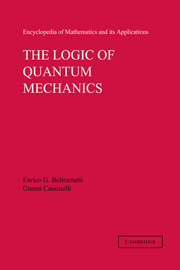Book contents
- Frontmatter
- Contents
- Editor's Statement
- Foreword
- Preface
- The Logic of Quantum Mechanics
- Part I HILBERT-SPACE QUANTUM MECHANICS
- Part II BASIC STRUCTURES IN THE DESCRIPTION OF QUANTUM SYSTEMS
- Chapter 10 The Typical Mathematical Structure of Propositions: Orthomodular AC Lattices
- Chapter 11 Probability Measures on Orthomodular Posets and Lattices
- Chapter 12 Characterization of Commutativity
- Chapter 13 States and Propositions of a Physical System
- Chapter 14 Quantum-Mechanical Features in Terms of the Logic of the Physical System
- Chapter 15 On the Hidden-Variables Issue
- Chapter 16 Proposition-State Structure and Idealized Measurements
- Chapter 17 Superpositions of States and Closure Spaces
- Chapter 18 Transition-Probability Spaces and Quantum Systems
- Chapter 19 On the Convex-Set Approach
- Chapter 20 Introduction to a Quantum Logic
- Part III RECONSTRUCTION OF HILBERT-SPACE QUANTUM MECHANICS
- Appendix A Trace-Class Operators
- Appendix B The Spectral Theorem
- Appendix C Proofs for Chapter 11
- Subject Index
- Miscellaneous Endmatter
Chapter 18 - Transition-Probability Spaces and Quantum Systems
Published online by Cambridge University Press: 05 June 2013
- Frontmatter
- Contents
- Editor's Statement
- Foreword
- Preface
- The Logic of Quantum Mechanics
- Part I HILBERT-SPACE QUANTUM MECHANICS
- Part II BASIC STRUCTURES IN THE DESCRIPTION OF QUANTUM SYSTEMS
- Chapter 10 The Typical Mathematical Structure of Propositions: Orthomodular AC Lattices
- Chapter 11 Probability Measures on Orthomodular Posets and Lattices
- Chapter 12 Characterization of Commutativity
- Chapter 13 States and Propositions of a Physical System
- Chapter 14 Quantum-Mechanical Features in Terms of the Logic of the Physical System
- Chapter 15 On the Hidden-Variables Issue
- Chapter 16 Proposition-State Structure and Idealized Measurements
- Chapter 17 Superpositions of States and Closure Spaces
- Chapter 18 Transition-Probability Spaces and Quantum Systems
- Chapter 19 On the Convex-Set Approach
- Chapter 20 Introduction to a Quantum Logic
- Part III RECONSTRUCTION OF HILBERT-SPACE QUANTUM MECHANICS
- Appendix A Trace-Class Operators
- Appendix B The Spectral Theorem
- Appendix C Proofs for Chapter 11
- Subject Index
- Miscellaneous Endmatter
Summary
Transition Probabilities between Pure States
In physicists' nomenclature the expression “transition probability” generally refers to some dynamical instability, more specifically to a nonzero probability for the system to make a transition from an initial to a final state. Our use of the term is not directly related to dynamical instabilities; rather we follow von Neumann's terminology, and the transition probability between two states is meant to represent, intuitively, a measure of their overlapping. To visualize this notion in an explicit example consider the states of linear polarization of a photon beam, let a be the polarization state filtered by a Nicol prism N1, and let β be the state filtered by a Nicol prism N2 rotated by an angle ϑ with respect to N1; then the transition probability between a and β is the probability for a photon in state α to pass N2, which is empirically known to be cos2 ϑ (Malus law), and equals the probability for a photon in state β to pass N1.
In the Hilbert-space formulation of quantum mechanics the idea of transition probability we have in mind is simply the modulus squared of the scalar product (see Sections 2.5 and 9.3).
- Type
- Chapter
- Information
- The Logic of Quantum Mechanics , pp. 199 - 207Publisher: Cambridge University PressPrint publication year: 1984

